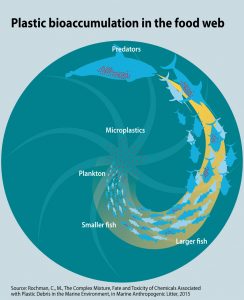PLASTIC IN YOUR PRAWNS
.
Last month’s newsletter from the DMF included a report from the Plymouth Marine Laboratory:
Are we underestimating microplastics in the marine environment
Devon Maritime Forum – June/July newsletter – Vision Group for Sidmouth
It’s something we can’t escape:
Microplastics everywhere – Vision Group for Sidmouth
And it’s something we considered two years ago, with PhD students from Plymouth:
Plymouth University PhD Talk 8th May 2018 – Sidmouth Plastic Warriors
Sidmouth Plastics week launched – Vision Group for Sidmouth
.
A correspondent has just sent in this report on how microplastics are entering the sea food chain:
.
 Biofilms occur on even small pieces of plastic and filter feeders are most at risk of infection, mussels could be wiped out in some areas:
Biofilms occur on even small pieces of plastic and filter feeders are most at risk of infection, mussels could be wiped out in some areas:
Analysis of Selected Plastics in High-Commercial-Value Australian Seafood
The Universities of Exeter and Queensland are working on joint projects:
Exeter’s research has produced alarming results:
Biological impact of microplastics on marine animals | Biosciences | University of Exeter
Exeter and Plymouth have produced material for GCSE students:
Unit | Plankton, Plastics and Poo Science 14-16 | Encounter Edu
Both the specialist and mainstream media have been reporting these findings:
There’s plastic in your prawns, UQ research reveals
Research reveals microplastic content levels in seafood
.
Microplastics are discovered in every sample of seafood purchased at a food market – with the equivalent of a grain of rice found in sardine flesh
- Scientists from universities of Queensland and Exeter bought seafood at market
- They dissolved microplastics in the edible tissue of each sample and studied it
- Discovered the microplastic polyvinyl chloride in every single specimen
- Most abundant was polyethylene which is the world’s most popular plastic
- Sardines were the worst affected delicacy, with up to 30mg of plastic per serving, approximately the same weight as a grain of rice
Microplastics found in every seafood sample bought at market | Daily Mail Online
.
Plastic pollution in our oceans could spread fatal diseases into the food chain through farmed seafoods such as mussels and oysters, study warns
- Scientists say microscopic plastic particles transport pathogens in the oceans
- Pathogens can contaminate our favourite seafood including oysters and mussels
- Knowledge gaps still exist over how microplastics carry these pathogens to fish
‘Microplastic fragments differ markedly from natural floating particles, and there is growing evidence that they represent a potential reservoir of pathogens,’ said Dr Ceri Lewis at the University of Exeter’s Global Systems Institute
.
photo: plastic-bioaccumulation-in-the-food-web_3ba9 (1) – Fleet Farming